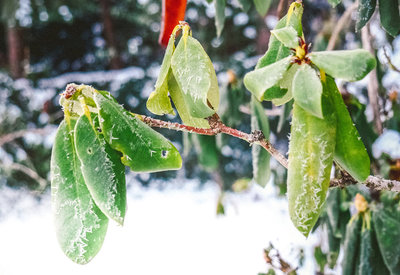
It could have been worse. December’s sudden deep freeze did quite a bit of damage to gardens in our area, and probably more out of town than in. But the relatively short duration of sub-zero temperatures, combined with an insulating blanket of snow, meant that the soil didn’t freeze deeply, which limited the damage. Many shrubs blackened by frost will send up a flush of new stems from the roots or from their protected lower branches. Veggies that were small enough to hide beneath the snow already show signs of new growth.
Now many gardeners are asking, what’s dead, what isn’t? Should I prune damaged plants, and if so, when? The best advice may be to avert your eyes from the garden and wait until spring to evaluate and prune. If you can’t wait to know if a plant is dead or alive, try this test: With a sharp blade or just your thumbnail, scratch off a small piece of bark from a few one- or two-year-old stems. If you see vibrant green tissue under the surface, the plant may still be alive. If the tissue is a dull green or brown, the above-ground parts of the plant — or at least the stems you tested — may be dead or dying. The roots, though, may be alive.
The broad-leafed evergreens are the group of plants most vulnerable to cold. Many rhododendrons appear to have come through unscathed. Others show pretty severe leaf burn but may still be alive. Leaf burn is much more evident on some other popular landscape plants, such as evergreen viburnum, Mexican orange blossom (choisya), camellia and ceonothus. Blackened ceonothus are probably dead. The others may recover.
Don’t be in a rush to cut things back, even if they look unsightly. It may be months before we know for sure what’s still alive, and top growth, even if it’s dead, offers some protection in future freezes. It won’t hurt, though, to prune away the burned tips of lightly damaged plants, like my choisya. If you absolutely can’t stand the sight of something and feel compelled to cut it down, leave some stumps and cover them with a pile of dead leaves or straw. If worst comes to worst, remember the resilient gardener’s motto: Every dead plant is an opportunity.
Personally, I’m concerned about my fig tree. Figs can pass the scratch test, yet carry dead buds. Heiko Keister, who has a lot of experience with exotic fruits, once advised me to put off pruning a frost-damaged fig until June because it’s hard to predict which twigs will generate new, live buds. He was right. And if by chance your fig appears completely dead, it will probably sprout from the ground. Gardeners in really cold climates sometimes grow figs like giant perennials, as foliage plants.
In my vegetable garden I’ve learned an important lesson. I planted purple sprouting broccoli, from purchased starts, a little late this year. Anxious to see the plants get established, I put them in fertile ground and then fed them twice with liquid fertilizer. They grew fast and looked great — until the freeze, when they mostly turned to mush. Even the stems exploded. A single plant that didn’t fit in the row was tucked in another bed. It missed out on the special treatment, and by winter it was smaller and more rugged looking than the others. It’s the only broccoli plant that still looks good. Red Russian kale, garlic, mache and even fava bean sprouts all survived. Would they have done so without that cozy snow-quilt? I’ll never know.
All about fruit trees: Just in time for the bare-root planting season, the OSU Extension Service and the Lane Small Business Development Center are partnering to offer a class about growing fruit trees. The class, taught by Ross Penhallegon and intended for both homeowners and small acreage farmers, will be held at 6 pm Wednesday, Feb. 19, on the LCC main campus in Eugene.
This class aims to show how to select and grow trees successfully: “Information about apples, prunes/plums, pears, cherries and peaches will be covered, including what you should know about rootstocks, spacing, soils, irrigation, fertility, site selection, plant problems and insects.”
The class costs $35 and pre-registration is required. To register, call the Lane Small Business Development Center at 463-6200.
Gray’s Garden Center is closing, apparently a victim of the recession and poor management. It was a little pricey, but the quality was consistent, and it was a very convenient place to shop. Let’s hope it finds a buyer. Best wishes to all the friendly folks who worked there.